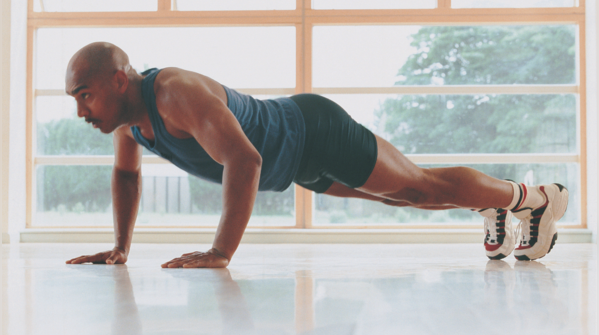- News
- lifestyle
- health-fitness
- fitness
- 5 benefits of doing just 20 push-ups every morning
5 benefits of doing just 20 push-ups every morning

What are the benefits of push-ups?
Starting the day with a simple exercise like push-ups can bring incredible benefits to overall health and fitness. Push-ups are a bodyweight exercise that engages multiple muscle groups, improves strength, and enhances endurance. While many assume push-ups require high repetitions to be effective, even doing just 20 every morning can have a lasting impact on physical health. This small habit can boost metabolism, strengthen the upper body, and contribute to better posture. Here’s a look at why 20 push-ups every morning can be a game-changer.

Builds upper body strength
Push-ups primarily target the chest, shoulders, and triceps, making them one of the best exercises for upper body strength. Regularly performing 20 push-ups each morning helps in maintaining muscle tone and improving endurance. Stronger upper body muscles contribute to better posture, reduce the risk of injuries, and support daily activities like lifting and carrying objects with ease.
Practicing Surya Namaskar in the Brahma Muhurta has these powerful benefits
Simple yoga poses to help people who snore during sleep

Want to improve your core?
Although push-ups are often seen as an upper-body workout, they also engage the core muscles. Holding the body in a straight position while performing the movement activates the abdominal muscles, lower back, and obliques. Over time, this improves core stability, leading to better balance and reduced strain on the lower back. A strong core plays a key role in preventing posture-related problems and enhances overall body coordination.

Say hello to a healthy heart
Push-ups are not just about building muscle; they also benefit the cardiovascular system. Performing push-ups increases heart rate, improving circulation and promoting better oxygen flow throughout the body. Studies have suggested that individuals who can do a moderate number of push-ups daily have a lower risk of developing heart-related issues. Engaging in this simple routine every morning supports heart health and helps in maintaining overall cardiovascular fitness.

Improves metabolism and fat burn
Physical activity in the morning jumpstarts metabolism, and push-ups are no exception. Since push-ups engage multiple muscle groups at once, they require more energy, leading to increased calorie burn. This helps in maintaining a healthy weight and supports fat loss over time. Additionally, building muscle mass contributes to a higher resting metabolic rate, meaning the body continues to burn calories even after the workout is over.
How rope skipping helps improve heart health

Strengthens bone and joint health
Weight-bearing exercises like push-ups help in maintaining strong bones and joints. Regular push-ups put controlled pressure on the bones, which stimulates bone density and reduces the risk of conditions like osteoporosis. Additionally, push-ups improve joint stability, especially in the shoulders and wrists, reducing the likelihood of injuries. Keeping the joints strong ensures better mobility and overall flexibility as the body ages.(Images: Canva)
This simple 1 minute test could tell you when will you die

Who should avoid doing push ups?
Push-ups are a great bodyweight exercise, but certain individuals should avoid them or modify the movement. Those with wrist, shoulder, or elbow injuries should steer clear, as the strain can worsen the condition. People with severe lower back pain or herniated discs may find push-ups aggravate their discomfort. Individuals with hypertension should be cautious, as the strain can spike blood pressure. Those recovering from surgery, especially upper body procedures, must consult a doctor before attempting push-ups. Pregnant women in later trimesters should modify or avoid the exercise. Beginners or overweight individuals should start with easier variations to prevent injury.

Why doing push ups are extremely important?
Push-ups are a very effective exercise that targets multiple muscle groups, including the chest, shoulders, triceps, and core. They help build strength and improve endurance, making them a great addition to any fitness routine. Aside from muscle development, push-ups enhance cardiovascular health by increasing heart rate and promoting blood circulation. They also engage stabilising muscles, contributing to better posture and balance.

How to maximize the effect of push-ups?
To maximize push-ups, focus on proper form. Keep your core tight, back straight, and hands shoulder-width apart. Engage your chest, shoulders, and triceps for maximum efficiency.
Increase endurance by practicing daily. Start with manageable sets and gradually add more reps. Try variations like wide-grip, diamond, and decline push-ups to target different muscles.
Use progressive overload by adding resistance, such as a weighted vest or resistance bands. Improve overall strength with complementary exercises like planks and bench presses.
Prioritize rest and recovery. Get enough sleep, eat protein-rich foods, and stretch to prevent injuries and enhance performance over time.
How many kilometers should we walk in day for weight loss?

Push up alternatives one can try
You've got plenty of effective push-up alternatives to explore, ranging from easier modifications like wall and knee push-ups to more challenging variations such as decline and close-grip push-ups, as well as exercises like planks, dumbbell chest presses, and triceps dips that target similar muscle groups; selecting the right alternative depends on your fitness level and specific goals.

How to make push ups easier?
To make push-ups easier, consider performing them on an elevated surface, focusing on the downward motion, or starting with a wall push-up. These modifications reduce the amount of weight your body needs to support, gradually building strength and making it easier to progress to standard push-ups. Read also: What happens to our body when we do surya namaskar daily (Image: CANVA)









